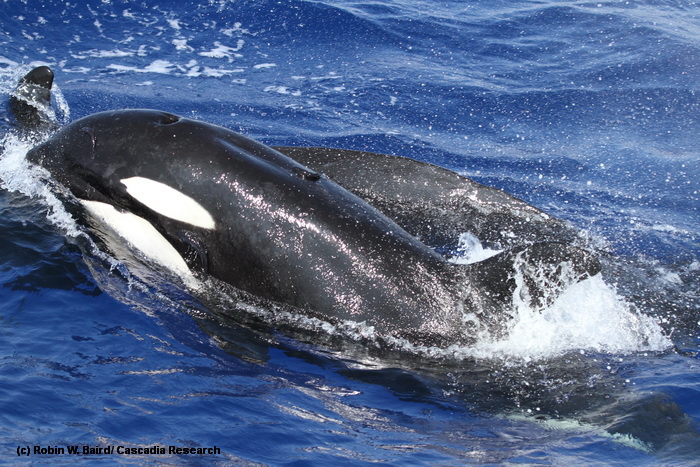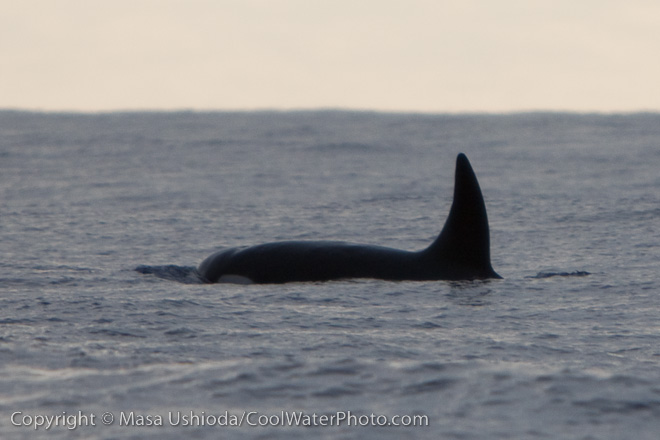Killer whales (Orcinus spp.) are found world-wide, and several populations are among the most well-known of any whale population in the world. In Hawaiian waters they are rare, to say the least. In a 2002 National Marine Fisheries Service survey of the entire Hawaiian Exclusive Economic Zone, extending 200 nautical miles (370 km) offshore of all the islands, including the Northwestern Hawaiian Islands, there were only two on-effort sightings of killer whales, and the resultant estimate of abundance in the entire area was only of 349 individuals (Barlow 2006). In our work, between 2000 and September 2022, covering over 145,000 km of trackline, we’ve only seen killer whales on six occasions, off Hawai‘i Island in May 2003, off Kaua‘i in July 2011, and off Hawai‘i Island in November 2013, July 2016, August 2022, and September 2022 (the last two sightings of the same group). In each case we were able to photo-identify the individuals present, four in four of the encounters, and seven in the last two encounters, but with the exception of the August and September 2022 encounters, none of the individuals matched between encounters. We have a small photo-identification catalog of this species in Hawaiian waters (77 individuals as of August 2022), but have had only a few matches, suggesting the individuals encountered around the islands are part of a larger open-ocean population.
The first ever long-term (>1 week) re-sighting of a killer whale from Hawaiian waters was made in October 2016, by comparing video footage of a group of killer whales taken off Moloka‘i by Tabitha Pupuhi on October 10, 2016, to photos taken off Kona in July 2016, both by the Pacific Island Fisheries Science Center and during our July 2016 field project! The July 2016 group was satellite tagged by the Pacific Island Fisheries Science Center and moved far north of the islands, and we tagged a different group in November 2013 that moved far to the west. In the August 2022 encounter we tagged another individual and obtained about a month of movement data. Together, the photo and satellite tag data suggest that killer whales in Hawaiian waters are part of a large population that broadly ranges over a wide part of the central tropical Pacific. However, the October 2016 and August and September 2022 re-sightings shows that the whales do loop back through the area, at least on occasion. We are hoping that more photos taken by ocean users in Hawai‘i will continue to help us understand this visitor to the islands!

In November 2013 we satellite tagged three killer whales in a group, and tracked their movements for 25 days. The animation above shows the movement of the group in relation to cyclonic (i.e., upwelling) and anti-cyclonic (i.e., downwelling) eddies.

A killer whale off the island of Hawai‘i, November 1, 2013. Note the small remora just beneath the eyepatch, a common hitchhiker on killer whales in the tropics.
In 2006 we published a compilation of 21 records of killer whales in Hawaiian waters from 1994 through 2004 (a copy can be downloaded here). From those records killer whales had been recorded during nine months of the year. Since then they’ve been recorded in two additional months (June and October), so the only month of the year they’ve not been recorded in Hawaiian waters is December.
Although there were more records during the humpback whale season, there are also more people on the water working with whales during that time of the year, so they don’t necessarily use Hawaiian waters more when humpback whales are around. Since that publication there have been a number of additional sighting records, and one stranding, of killer whales around the main Hawaiian Islands, but these records likely reflect more people on the water and more communication among those who see the whales than any actual increase in the number of killer whales using the main Hawaiian Islands.

An adult male off the island of Hawai‘i, June 9, 2009.
There is no evidence of a “resident” population of killer whales in Hawai‘i – whales seen around the main Hawaiian Islands are likely part of a wide-ranging population that inhabits the central Pacific. There are some physical differences from killer whales seen in Hawai‘i compared to the well-known populations along the west coast of North America. The saddle patch (the gray area below and behind the dorsal fin) is very narrow in killer whales in Hawai‘i, and also not very bright (i.e., difficult to see except in ideal light conditions).
For more information:
- Jarvis, S.M., E.E. Henderson, T.J. Brookens and D.L. Webster. 2019. Acoustic observation of the reaction of rough-toothed dolphin (Steno bredanensis) to vocalizations, most likely from killer whale (Orcinus orca), off Kaua‘i. Marine Mammal Science 10.1111/mms.12580. Download PDF copy
- Baird, R.W. 2016. Killer whales. In The Lives of Hawai‘i’s Dolphins and Whales: Natural History and Conservation. University of Hawai‘i Press, Honolulu. Download PDF copy
- Baird, R.W., D.L. Webster, J.M. Aschettino, G.S. Schorr and D.J. McSweeney. 2013. Odontocete cetaceans around the main Hawaiian Islands: habitat use and relative abundance from small-boat sighting surveys. Aquatic Mammals 39:253-269. Download PDF copy
- Baird, R.W., D.J. McSweeney, C. Bane, J. Barlow, D.R. Salden, L.K. Antoine, R.G. LeDuc, and D.L. Webster. 2006. Killer whales in Hawaiian waters: information on population identity and feeding habits. Pacific Science 60:523-530. Download PDF copy
- Cascadia Research’s killer whale web page
All photos are copyrighted and should not be used without permission.
Updated June 2024.
Return to the Hawaiian Dolphin and Whale Species Page
Got photos? We have photo-ID catalogs for several Hawaiian cetacean species! If you have photos that you would be willing to share, you can learn how to submit those to us at this link, or contact us at Hawaii@cascadiaresearch.org